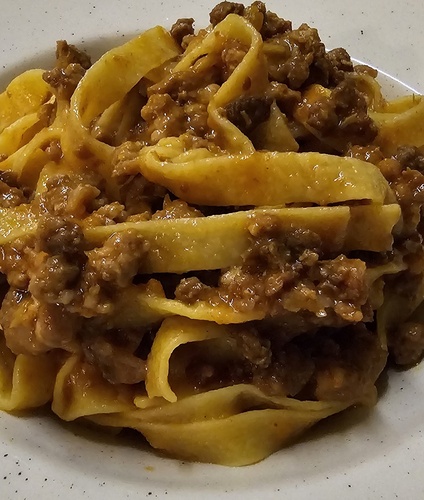
RAGU’ BOLOGNESE: AMONG HISTORY AND TRADITIONS
April 01 2025
CURIOSITIES BOLOGNA 
If you come to Bologna you can not miss the traditional dish of tagliatelle al ragù bolognese , a source of great pride for the city.
Born as a meat-based dish in Renaissance France, the recipe for Ragù has arrived up to the Bourbon Neapolitan court and then expanded throughout the Italian peninsula.
It was the era in which the nobles dictated trends in fashion, customs and culinary art.
Nowadays, the Ragù Bolognese is one of the most famous recipes in the world. And right here, in the historical center of Bologna , a few steps from our charming hotel, you can find a lot of typical restaurants where you can taste the authentic Ragù Bolognese .
Now world-famous, ragù Bolognese has spread abroad thanks to Italian emigrants which brought with them the flavors of their native land, showing multiple international variations, such as Spaghetti Bolognese , even if this dish doesn't actually exist !
It is an American invention which involves the use of the original recipe but prepared with local ingredients and taste. Therefore, if you come to Bologna, never ask for Spaghetti Bolognese, they won’t serve you !
But where does Ragù originate and where do its two most famous versions (the Neapolitan and the Bolognese) come from?
THE HISTORY
It is common to trace the origin of the term Ragù to the French word “ragoutRagù
was in fact a preparation of the popular medieval French tradition of the XII-XIV century, which involved stewing pieces of meat, vegetables or even fish over a low heat, and in broth.
Depending on the cuts of meat, the spices and the garnishes that were used, it could be cooked both by the less wealthy groups and by the court and, obviously, it did not involve the use of tomato sauce.
From France to Italy, this dish spread through the cuisine of the Neapolitan Bourbon court and those of the Vatican, but it is still a method of cooking meat with a lot of variations.
In 1773 the first Neapolitan variant of the French stew was born. Vincenzo Corrado in his haute cuisine book “Il cuoco galanteragù , even if the ingredients are not yet limited and the cooking is still done in broth with vegetables and aromatic herbs.
From this moment on, it is used to flavor other dishes or as a filling, however there is still no trace of pasta or tomato sauce.
The use this sauce appears for the first time in “Maccheroni alla Napolitana”, contained in the recipe book “l’Apicio moderno” by Francesco Leonardi from 1790.
In the following years, versions of the same dish will alternate with or without the addition of tomato sauce and only during the twentieth century the definitive transformation takes place with the diffusion of tomato sauce and pasta, taking on the characteristics of the Ragù that we still appreciate today.
At the same time, however, throughout the 19th century Ragù spread throughout the peninsula with the introduction of local variations, such as the use of pork (initially not contemplated), the preparation of small meatballs and the combination with certain types of local pasta, such as sfoglia in Emilia.
RAGU’ BOLOGNESE
In 1891 Pellegrino Artusi, the so-called inventor of italian cuisine, in his “Science in the Kitchen and the Art of eating well” describes “Maccheroni alla bolognese”, thus laying the groundwork for one of the most famous culinary myths of italian cuisine.
The tomato sauce is not yet included, but almost all the other ingredients are there: salted pork belly, veal seasoned with celery, carrot and onion, all cooked in meat broth.
Artusi also suggests some additions to improve this seasoning: dried mushrooms, truffle, chicken livers and cream…it is a white ragù
in which has no place tomato sauce yet, but rich and tasty, as the Bolognese tradition wanted.
The definitive turning point came at the end of the first decade of the twentieth century when almost all gastronomic authors opted for the substitution of tagliatelle
instead of maccheroni (a variant already suggested by Artusi) and for the constant inclusion of tomato sauce.
Only after the Second World War did the ingredients of Ragù
finally include fresh pork, as reported in the famous “Il Cucchiaio d’Argento”
, proposing a recipe that has remained substantially unchanged to this day.
The definitive recipe for Ragù was deposited in 1982 at the Bologna Chamber of Commerce by the Bologna Delegation of the Italian Academy of Cuisine.
THE REGISTERED RECIPE FOR RAGU’ BOLOGNESE
The registered recipe of Ragù Bolognese requires the use of the following ingredients: coarse ground beef, pork belly, carrots, celery and onions, tomato sauce, white wine, milk, a little broth, extra virgin olive oil, salt and pepper.
After having finely chopped the bacon and left it brown, add the chopped vegetables and the minced meat, stirring until sizzling.
Then add the wine, tomato sauce, the broth and the milk, leaving all the ingredients to simmer for about two hours. Finally season with salt and pepper
TASTE RAGU’ IN THE HEART OF BOLOGNA
Without any doubt, Bologna is home to a large number of traditional restaurants that serve dishes accompanied by ragù, especially tagliatelle. Fortunately, thanks to the location of our https://en.art-hotel-commercianti.com/map/ luxury hotel in the historic center of Bologna ¸the majority of the best restaurants are just a few minutes walking.
Therefore, if you are a fan of Italian cuisine
and want to take part in it, you can not miss the opportunity to taste the Bolognese ragù
and explore the fascinating city in which you are immersed, staying in our
charming hotel https://en.art-hotel-commercianti.com/
or in our
apartments in the historic center of the city https://www.art-hotel-commercianti.com/appartamenti/ .
.
We are waiting for you !
Rückkehr
Born as a meat-based dish in Renaissance France, the recipe for Ragù has arrived up to the Bourbon Neapolitan court and then expanded throughout the Italian peninsula.
It was the era in which the nobles dictated trends in fashion, customs and culinary art.
Nowadays, the Ragù Bolognese is one of the most famous recipes in the world. And right here, in the historical center of Bologna , a few steps from our charming hotel, you can find a lot of typical restaurants where you can taste the authentic Ragù Bolognese .
Now world-famous, ragù Bolognese has spread abroad thanks to Italian emigrants which brought with them the flavors of their native land, showing multiple international variations, such as Spaghetti Bolognese , even if this dish doesn't actually exist !
It is an American invention which involves the use of the original recipe but prepared with local ingredients and taste. Therefore, if you come to Bologna, never ask for Spaghetti Bolognese, they won’t serve you !
But where does Ragù originate and where do its two most famous versions (the Neapolitan and the Bolognese) come from?
THE HISTORY
It is common to trace the origin of the term Ragù to the French word “ragoutRagù
was in fact a preparation of the popular medieval French tradition of the XII-XIV century, which involved stewing pieces of meat, vegetables or even fish over a low heat, and in broth.
Depending on the cuts of meat, the spices and the garnishes that were used, it could be cooked both by the less wealthy groups and by the court and, obviously, it did not involve the use of tomato sauce.
From France to Italy, this dish spread through the cuisine of the Neapolitan Bourbon court and those of the Vatican, but it is still a method of cooking meat with a lot of variations.
In 1773 the first Neapolitan variant of the French stew was born. Vincenzo Corrado in his haute cuisine book “Il cuoco galanteragù , even if the ingredients are not yet limited and the cooking is still done in broth with vegetables and aromatic herbs.
From this moment on, it is used to flavor other dishes or as a filling, however there is still no trace of pasta or tomato sauce.
The use this sauce appears for the first time in “Maccheroni alla Napolitana”, contained in the recipe book “l’Apicio moderno” by Francesco Leonardi from 1790.
In the following years, versions of the same dish will alternate with or without the addition of tomato sauce and only during the twentieth century the definitive transformation takes place with the diffusion of tomato sauce and pasta, taking on the characteristics of the Ragù that we still appreciate today.
At the same time, however, throughout the 19th century Ragù spread throughout the peninsula with the introduction of local variations, such as the use of pork (initially not contemplated), the preparation of small meatballs and the combination with certain types of local pasta, such as sfoglia in Emilia.
RAGU’ BOLOGNESE
In 1891 Pellegrino Artusi, the so-called inventor of italian cuisine, in his “Science in the Kitchen and the Art of eating well” describes “Maccheroni alla bolognese”, thus laying the groundwork for one of the most famous culinary myths of italian cuisine.
The tomato sauce is not yet included, but almost all the other ingredients are there: salted pork belly, veal seasoned with celery, carrot and onion, all cooked in meat broth.
Artusi also suggests some additions to improve this seasoning: dried mushrooms, truffle, chicken livers and cream…it is a white ragù
in which has no place tomato sauce yet, but rich and tasty, as the Bolognese tradition wanted.
The definitive turning point came at the end of the first decade of the twentieth century when almost all gastronomic authors opted for the substitution of tagliatelle
instead of maccheroni (a variant already suggested by Artusi) and for the constant inclusion of tomato sauce.
Only after the Second World War did the ingredients of Ragù
finally include fresh pork, as reported in the famous “Il Cucchiaio d’Argento”
, proposing a recipe that has remained substantially unchanged to this day.
The definitive recipe for Ragù was deposited in 1982 at the Bologna Chamber of Commerce by the Bologna Delegation of the Italian Academy of Cuisine.
THE REGISTERED RECIPE FOR RAGU’ BOLOGNESE
The registered recipe of Ragù Bolognese requires the use of the following ingredients: coarse ground beef, pork belly, carrots, celery and onions, tomato sauce, white wine, milk, a little broth, extra virgin olive oil, salt and pepper.
After having finely chopped the bacon and left it brown, add the chopped vegetables and the minced meat, stirring until sizzling.
Then add the wine, tomato sauce, the broth and the milk, leaving all the ingredients to simmer for about two hours. Finally season with salt and pepper
TASTE RAGU’ IN THE HEART OF BOLOGNA
Without any doubt, Bologna is home to a large number of traditional restaurants that serve dishes accompanied by ragù, especially tagliatelle. Fortunately, thanks to the location of our https://en.art-hotel-commercianti.com/map/ luxury hotel in the historic center of Bologna ¸the majority of the best restaurants are just a few minutes walking.
Therefore, if you are a fan of Italian cuisine
and want to take part in it, you can not miss the opportunity to taste the Bolognese ragù
and explore the fascinating city in which you are immersed, staying in our
charming hotel https://en.art-hotel-commercianti.com/
or in our
apartments in the historic center of the city https://www.art-hotel-commercianti.com/appartamenti/ .
.
We are waiting for you !

